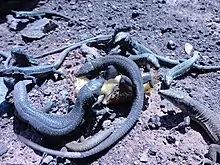| Madeiran wall lizard | |
|---|---|
 | |
| Scientific classification | |
| Domain: | Eukaryota |
| Kingdom: | Animalia |
| Phylum: | Chordata |
| Class: | Reptilia |
| Order: | Squamata |
| Family: | Lacertidae |
| Genus: | Teira Gray, 1838 |
| Species: | T. dugesii |
| Binomial name | |
| Teira dugesii (Milne-Edwards, 1829) | |
| Synonyms[2] | |

The Madeiran wall lizard (Teira dugesii) is a species of lizard in the family Lacertidae. It is the only species in the genus Teira. The species is endemic to the Madeira Archipelago, Portugal. In the Azores, this lizard has become naturalized after involuntary introduction by the shipping trade between the two archipelagos. There are four recognized subspecies.
Etymology
The specific name, dugesii, is in honor of French physician and naturalist Antoine Louis Dugès.[3]
Habitat
The Madeiran wall lizard's natural habitats are temperate forests and shrublands, Mediterranean-type shrubby vegetation, rocky areas, rocky shores, sandy shores, arable land, pastureland, plantations, rural gardens, and urban areas.[1]
Subspecies
The following four subspecies are recognized as being valid, including the nominotypical subspecies.[4]
- Teira dugesii dugesii (Milne-Edwards, 1829)
- Teira dugesii jogeri (Bischoff, Osenegg & Mayer, 1989); named after German herpetologist Ulrich Joger[3]
- Teira dugesii mauli (Mertens, 1938)
- Teira dugesii selvagensis (Bischoff, Osenegg & Mayer, 1989); named after the Selvagens Islands
Nota bene: A trinomial authority in parentheses indicates that the subspecies was originally described in a genus other than Teira.
Description
The Madeiran wall lizard grows to a snout-to-vent length (SVL) of about 8 cm (3.1 in) with a tail about 1.7 times the length of its body. The colouring is variable and tends to match the colour of the animal's surroundings, being some shade of brown or grey with occasionally a greenish tinge. Most animals are finely flecked with darker markings. The underparts are white or cream, sometimes with dark spots, with some males having orange or red underparts and blue throats, but these bright colours may fade if the animal is disturbed.[5]
Behaviour
The Madeiran wall lizard is very common on the island of Madeira where it is the only small lizard, ranging from sea coasts to altitudes of 1,850 metres (6,070 ft). It is usually found in rocky places or among scrub and may climb into trees. It is also found in gardens and on the walls of buildings. The tail is easily shed and the stump regenerates slowly.[5]
Diet
The Madeiran wall lizard feeds on small invertebrates such as ants and also eats some vegetable matter such as bananas.[5]
Reproduction
Adult females of T. dugesii lay two to three clutches of eggs in a year with the juveniles being about 3 cm (1.2 in) when they hatch.[5]
Ecoepidemiology
T. dugesii is one of many species that may be parasitized by ticks and can act as a secondary or alternative reservoir for Lyme disease or other tick-borne zoonoses.[6] Large warm-blooded mammals like deer and boar seem to have become the first epidemiologic tank (and/or host) for European ticks.[7]
References
- 1 2 Sá-Sousa, Paulo; Sindaco, Roberto (2009). "Teira dugesii (errata version published in 2017)". IUCN Red List of Threatened Species. 2009: e.T61521A121720531. Accessed 29 September 2022.
- ↑ Species Teira dugesii at The Reptile Database www.reptile-database.org.
- 1 2 Beolens, Bo; Watkins, Michael; Grayson, Michael (2011). The Eponym Dictionary of Reptiles. Baltimore: Johns Hopkins University Press. xiii + 296 pp. ISBN 978-1-4214-0135-5. (Lacerta dugesii, p. 76; "Joger", p. 135).
- ↑ "Oldstyle id: 7d33bdd95b453151f9ad92386a79cec2". Catalogue of Life. Species 2000: Leiden, the Netherlands.
- 1 2 3 4 Arnold, E. Nicholas [in French]; Ovenden, Denys W. (2002). Field Guide: Reptiles & Amphibians of Britain & Europe. London: Collins & Co. pp. 154–155. ISBN 9780002199643.
- ↑ De Sousa R, Lopes de Carvalho I, Santos AS, Bernardes C, Milhano N, Jesus J, Menezes D, Nuncio MS (2012). "Role of the lizard Teira dugesii as a potential host for Ixodes ricinus tick-borne pathogens". Applied and Environmental Microbiology 78 (10): 3767–3769.
- ↑ Wodecka B, Rymaszewska A, Skotarczak B (2014). "Host and pathogen DNA identification in blood meals of nymphal Ixodes ricinus ticks from forest parks and rural forests of Poland". Experimental and Applied Acarology 62 (4): 543-555. (résumé).
Further reading
- Engelmann, Wolf-Eberhard; Fitzsche, Jürgen; Günther, Rainer; Obst, Fritz Jürgen (1993). Lurche und Kriechtiere Europas: Beobachten und bestimmen. Radebeul, Germany: Neumann Verlag. 440 pp., 324 color plates, 186 figures, 205 maps. (Podarcis dugesii, new combination). (in German).
- Mayer W, Bischoff W (1996). "Beiträge zur taxonomischen Revision der Gattung Lacerta (Reptilia: Lacertidae) Teil 1: Zootoca, Omanosaura, Timon und Teira als eigenständige Gattungen ". Salamandra 32 (3): 163–170. (Teira dugesii, new combination). (in German).
- Milne-Edwards H (1829). "Recherches zoologiques pour servir à l'histoire des Lézards, extraites d'une Monographie de ce genre". Annales des Sciences Naturelles, Paris 16: 50–89 + Plates V–VIII. (Lacerta dugesii, new species, p. 84 + Plate VI, figure 2). (in French).
